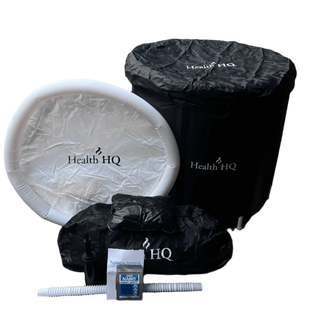How Do Ice Baths Work for Recovery?
In the world of fitness and sports performance, ice baths have emerged as a popular tool for accelerating recovery. But how exactly do these chilly plunges help your body bounce back after a tough workout? In this post, we’ll break down the science behind ice baths, explaining the physiological mechanisms that make them such an effective recovery strategy.
The Science Behind the Chill
Vasoconstriction and Vasodilation
One of the primary ways ice baths aid recovery is through the process of vasoconstriction. When you immerse your body in cold water, your blood vessels constrict, meaning they become narrower. This response helps reduce blood flow to the muscles, which can minimize swelling and inflammation. Once you exit the ice bath, your blood vessels dilate (widen), a process that increases circulation. The improved blood flow helps remove metabolic waste products—like lactic acid—and delivers fresh oxygen and nutrients to the muscles, kickstarting the repair process.
Reduced Inflammation
Intense exercise often leads to micro-tears in your muscle fibers, triggering an inflammatory response. Although inflammation is a natural part of the healing process, excessive inflammation can lead to prolonged soreness and delayed recovery. The cold water in an ice bath helps reduce this inflammatory response by slowing down the cellular processes that cause inflammation, thereby minimizing post-exercise discomfort and aiding quicker recovery.
Pain Relief Through Numbing Effects
Another benefit of cold water immersion is its pain-relieving effect. The cold temperature can numb nerve endings, reducing the perception of pain. This numbing effect is especially beneficial immediately after a high-intensity workout, when muscle soreness and minor pain are most pronounced. By decreasing pain sensation, ice baths allow you to recover with greater comfort and potentially resume training sooner.
Beyond the Physical: Mental Benefits
While the physiological effects of ice baths on muscle recovery are significant, many users also report mental benefits. The initial shock of cold water forces you to focus on controlled breathing and staying calm, which can help build mental resilience over time. Embracing this discomfort not only sharpens your mind during recovery sessions but can also translate into improved stress management and mental toughness in everyday life.
Timing and Application: Maximizing the Benefits
When to Take an Ice Bath
For optimal benefits, the timing of your ice bath is crucial. Most experts recommend taking an ice bath immediately after intense exercise. This timing helps reduce the buildup of inflammation before it has a chance to intensify. However, some athletes choose to wait a short period—around 20 to 30 minutes—to allow initial recovery processes to begin before diving into the cold water.
Duration of Immersion
Staying in an ice bath for about 10 to 15 minutes is considered optimal for most people. This duration is long enough to trigger the beneficial physiological responses such as vasoconstriction and reduced inflammation, while minimizing the risk of adverse effects like excessive numbness or hypothermia. As with any recovery tool, it's important to listen to your body and adjust the duration based on your comfort level and experience.
How Ice Baths Compare with Other Recovery Modalities
Ice baths aren’t the only recovery method available. They are often compared to other techniques such as contrast water therapy (alternating between hot and cold treatments) and saunas. While saunas promote recovery through heat, relaxing muscles and increasing circulation over a longer term, ice baths offer rapid, immediate relief through the quick dampening of inflammation and pain. Many athletes find that combining these approaches—using an ice bath followed by a sauna session—provides a well-rounded strategy for both immediate recovery and long-term muscle health.
Final Thoughts
Ice baths work for recovery by leveraging your body's natural physiological responses. The processes of vasoconstriction and subsequent vasodilation, combined with the reduction of inflammation and pain through nerve numbing, create an ideal environment for muscle repair. Beyond physical benefits, the mental resilience built through regular exposure to cold is an added advantage that enhances overall performance.
Whether you’re a competitive athlete or someone looking to reduce post-workout soreness, understanding and applying the science behind ice baths can help you optimize your recovery routine. Have you tried an ice bath? Share your experiences and thoughts in the comments below—let’s continue the conversation on how we can all recover smarter!








